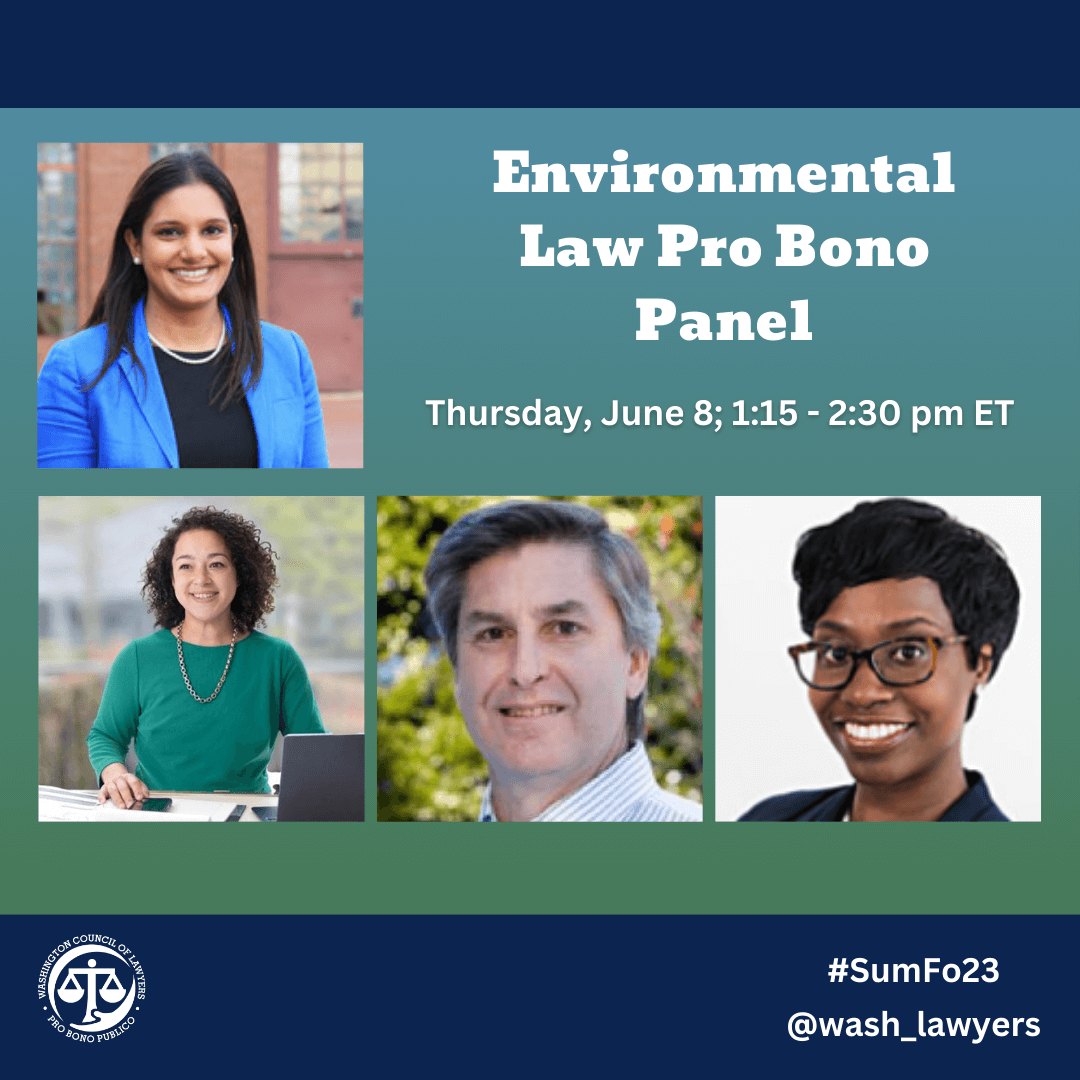
2023 Summer Forum: NEW! Ways to Protect Our World!
On June 8, 2023, we hosted our first-ever Environmental Justice panel during our Summer Public Interest and Pro Bono Forum. The lively discussion covered the work our panelists do and how they find opportunities to include environmental justice (EJ) in that work every day. Then panelists dove into what EJ means to them, including what EJ work is at its very core. The panelists provided tips for creating an EJ practice and getting involved with pro bono work that helps the environment! Our conversation also highlighted the importance of community-based advocacy and how EJ intersects with racism in the world and the law. Finally, our panelists concluded with practical tips on how to do EJ while working for the government and how to lobby for EJ issues.
Our Environmental Justice panel was moderated by Prianka Sharma, an environmental attorney for the federal government and Vice President of the Board for Washington Council of Lawyers. Our panelists include John (“Jay”) Pendergrass, Senior Vice President at the Environmental Law Institute; Christine Appah, Adjunct Professor of Law at the Benjamin N. Cardozo School of Law and Columbia Climate School; and Stacey Sublett Halliday, Principal at Beveridge & Diamond. Learn more about our panelists’ backgrounds here.
When discussing what environmental justice is, our panelists agreed that it’s a cross-cutting community issue built on the ideals of fairness and access. Jay described his first experience with environmental injustice on what was called “Cancer Alley” in Baton Rouge, LA where there were processions of big chemical plants in Black communities. Now Jay spends his days creating information for communities to know what the rules require, what their rights are, and where they can get involved through the Environmental Law Institute (ELI). Stacey highlights how her practice was made easier, if not possible, by the Biden Administration’s Executive Orders making EJ an important business consideration so companies stay eligible for grants or don’t receive fines. Stacey works creatively with this emerging area of the law and her clients to assist them in prioritizing EJ at decision-making points. From grassroots communities to the corporations that impact them, environmental justice is a concern for everyone.
As a professor of Environmental Justice, Christine gave us insight into what EJ is at its core, a fight for fairness and accessibility. She described the balance between industrialization and access to clean air, land, and water. Advancement in our country has historically impacted communities of color unfairly, especially Black communities. This was made possible through property laws, tax laws, zoning laws, redlining, and more. Our legal system has prejudiced communities of color and made it easier to reduce their access to a clean environment and unfairly shifts the burden of negative environmental impacts of industrialization. Christine highlighted the opportunities coming from the Biden Administration through Executive Orders that are creating mechanisms to get solutions oriented toward greater fairness.
Our panel then discussed the many ways to get involved in EJ work. Stacey discussed the ways her firm came together to make their environmental justice practice group. Starting with the impact of the Biden Administration, Stacey discussed how certain executive orders have made a more robust business case for clients to consider environmental justice at decision points. She highlighted the EPA Legal Tools to Advance EJ as a great guide as well as the ELI. Jay then discussed pro bono opportunities, starting with the ELI’s pro bono clearinghouse where communities post a brief description of matters they need assistance with and lawyers sign up to take on those matters. The ELI provides community lawyering CLE training to help prepare pro bono attorneys for taking on cases. Jay also highlighted resources available for attorneys looking for more of a crash course in EJ work including ELI Summer School, EJ Handbook, and ELI Bootcamp.
The conversation demonstrated the cross-cutting community-based advocacy that makes up EJ work through practical examples. Jay listed examples from the pro bono clearinghouse including: overburden of pollution, tax advice, incorporation fillings, projects that varied in time commitment, and opportunities for students. Christine described opportunities to assist communities such as writing op-ed pieces, engaging in legislative advocacy, drafting testimony, engaging in the comment process, or lobbying. She emphasized the importance of beginning where people meet and allowing communities to speak authentically about the issues they face. You will find that people come together and talk about EJ issues because they are talking about their lives which inherently involve the environment in which they live. She also cautioned to not treat problems like a cause and to remain present and authentic in assisting and amplifying a communities’ voice. Jay recommends folks hoping to assist in the commenting process read: The Art of Commenting.
In parting words, our panelists highlighted how there are so many opportunities to advocate for the environment. Start where you are and follow your passions. This is an exciting time to get involved and all people should feel welcomed because there is room for everyone to make meaningful contributions to this work!






